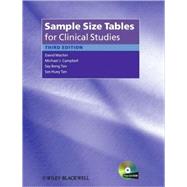
David Machin, Children’s Cancer and Leukaemia Group, University of Leicester, UK; Division of Clinical Trials and Epidemiological Sciences, National Cancer Centre, Singapore; Medical Statistics Unit, School of Health and Related Sciences, University of Sheffield, UK
Michael J. Campbell, Medical Statistics Unit, School of Health and Related Sciences, University of Sheffield, UK
Say Beng Tan, Singapore Clinical Research Institute, Singapore; Duke–NUS Graduate Medical School, Singapore
Sze Huey Tan, Division of Clinical Trials and Epidemiological Sciences, National Cancer Centre, Singapore
The New copy of this book will include any supplemental materials advertised. Please check the title of the book to determine if it should include any access cards, study guides, lab manuals, CDs, etc.
The Used, Rental and eBook copies of this book are not guaranteed to include any supplemental materials. Typically, only the book itself is included. This is true even if the title states it includes any access cards, study guides, lab manuals, CDs, etc.